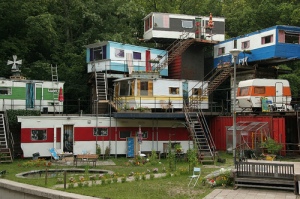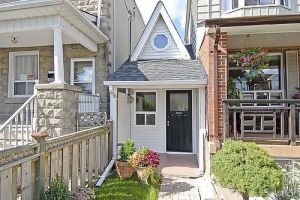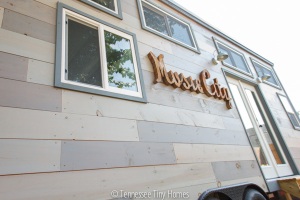Have you heard about the Tiny House Movement, but aren’t sure what it’s all about? We weren’t either, until our Engage Green Workshop: Tiny House, Big Impact! Did you know there’s a Tiny House right here in Music City?!
John and Sarah Murphy were a Washington D.C. couple who move to Nashville to be closer to their family. While living in their 1,500 sq foot DC apartment, they noticed all the wasted space surrounding them. Their closets were stuffed with belongings they didn’t need, and most of their furniture was purchased just to fill the space. The only rooms they REALLY spent quality time in was their kitchen and living room. The bedroom was for sleeping and their bathroom was just for… well, you know… so why was so much space dedicated to those rooms? After a lot of research and contemplation they finally decided to build a Tiny Home in Nashville.
However, halfway through the planning process they learned that residential codes in Nashville put a lot of restrictions on their plans. For example, a legal residence must be a minimum of 300 sq feet and their Tiny House plans were only for 200 sq feet. They had to decide, “Is this really something we want to pour our money into” when they knew they wouldn’t be able to actually live in it.
Their answer was YES, and they had some pretty good reasons, too!
Small House vs. Tiny House vs. RV
What’s the real difference? A Small House is simply that: a small house. It’s built on a foundation, but has a very space-efficient and compact floor plan. Locally, these structures are referred to as DADUs (Detached Accessory Dwelling Unit) and can only exist as an additional structure where a legal residential unit stands. A Tiny House, like Music City Tiny House (link here), is constructed on a trailer and therefore must be registered as an RV and comply with dimensions required for roadway transportation. Why then, would you spend your money building a Tiny House when you can buy a Winnebago? For starters, a Tiny House is customized for your own personal needs, whereas an RV is a cookie-cutter product. John is a chef by profession, so their kitchen was the most important part of their design. Additionally, everything is home-grade quality, from the appliances to the construction materials.
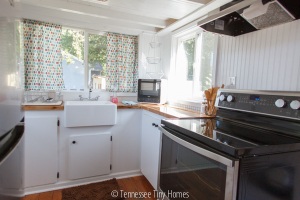
RVs on the other hand are primarily made from fiberglass and, just like a vehicle, eventually quits working. When you compare the prices of these mobile living units (that you actually plan to live in), a Tiny House is more cost effective. John and Sarah spent $45k on their project, from building materials, to appliances, to insulation, to the sheets on their bed. A used RV will cost half, and a brand new luxury model can cost well over $300k!
Everything Has It’s Place
Possibly the most spectacular thing about a Tiny House or Small House is that everything has its place. Every nook and cranny serves a purpose, and your buying habits conform to your actual storage capacity (which in turn helps your pocketbook).
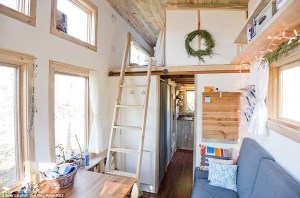 Likewise, Tiny Houses and Small Houses have their place, too. Unfortunately, due to outdated codes and regulations that haven’t caught up with the realities of modern technology, owners of these space-efficient domiciles are hiding them in backyards or in the middle of 5 acres of countryside. “These homes belong in urban centers,” says Sarah Murphy. “It costs three times more to keep people on the streets than it would to put them in tiny houses” and Tiny Houses “consume only 75% as much energy as a standard house.”
Likewise, Tiny Houses and Small Houses have their place, too. Unfortunately, due to outdated codes and regulations that haven’t caught up with the realities of modern technology, owners of these space-efficient domiciles are hiding them in backyards or in the middle of 5 acres of countryside. “These homes belong in urban centers,” says Sarah Murphy. “It costs three times more to keep people on the streets than it would to put them in tiny houses” and Tiny Houses “consume only 75% as much energy as a standard house.”
Plus, a Tiny House park would be much more quaint than a trailer park…
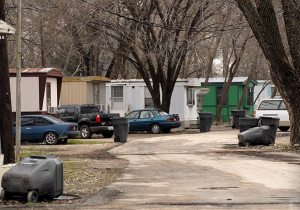 Unless they all looked like this…
Unless they all looked like this…
Empty Nesters with too much Nest
Another great point made by the happy couple is the fact that the Baby Boomer Generation is moving into the empty-nester stage of life, but the supply of downsize options is demishing. Smaller houses are being torn down to build larger houses, with smaller yards, which leaves individuals with a lot of space and not-a-lot of belongings in a rut.
If You Build It…
Actually, Sarah’s version of the quote was “If You Don’t Build It…” A movement can’t go far until people take the initiative to move it forward. If no one takes the time and money to actually build these Tiny Houses and Small Houses, and prove that they are livable and safe options, the movement stops. John and Sarah truly hope that someday they’ll be able to make their Tiny House a Tiny Home, and in the meantime they’ll use their Tiny House as a way to create awareness, discussion, and inspiration for others to keep the movement going.
Though John and Sarah Murphy aren’t able to live in their Tiny House (yet), they do rent it out as a “guest house” in Music City. To learn more or reserve a night, visit MusicCityTinyHouse.com.
Did you love this topic? We partner with Urban Green Lab on the first Wednesday of every month to bring you different sustainability-related topics through our Engage Green Series, including our next workshop on October 1st about fall seasonal cooking!
– Keeley (Team Green’s Director)

